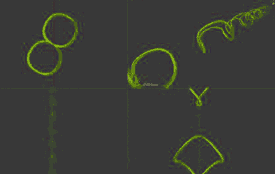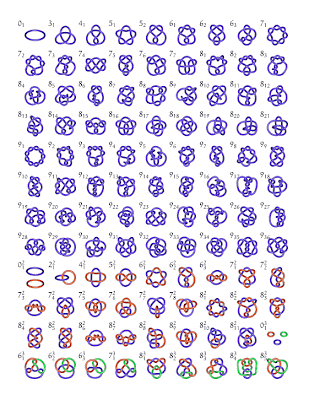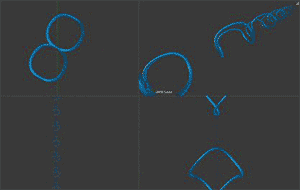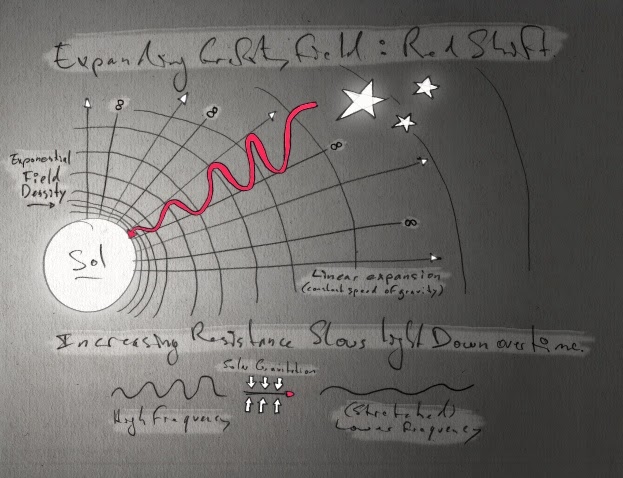One thing leads to another … if you want to research a universe based in Aether, and where the basic building blocks are: Points (.), Toruses-knots (o), Lemniscate rings (8) and Trefoil-knots (-<), and where there is basic interaction, than you'll quickly end up with a complex structure of layer upon layer, similar to the
Mandelbrot set, where you can zoom-in and discover new structures that interact, forming a network that makes everything tick in it's own relative framework, and you will find out that Aether is like a jungle.
Let's give it a try, for a structured universe, the points that make up the Aether need to have a starting point that has some potential. The easiest way to create such a potential is a pressed together group of points that creates a gateway or simply put a ring: O. Now let's do a thought-experimentwhat and see what kind of actions a 'hoop' could activate in a sea of points. First of all some points will pass through the 'O', while others cannot, this creates the first pressurised situation and a potential difference, a current will develop going from A -o-> B. By having this potential the 'O' will generate a sphere like current around it's self, with a magnitude that is in relation to the opening, the thickness of the 'hoop', the thickness of the particles and the density of the particles.
If we take in account that the collisions between points are elastic and the 'O' maintains it solid structure than eventually, due to turbulence differences, motion flows patterns will be generated by the particles that are pushed through the 'O' and acceleration. The only possible way these patterns can sustain there motion is when particles slipstream behind each other making infinite close looping. This can only happen when they are in close contact and spin at the same frequency, having the same vertex motion. For this infinite looping motion to happen, there are probably only 3 possible compositions that have the symmetry and the structure to do so without losing energy:
a. Spiraling Torus: (O)
b. Twisted Spiraling Torus: (8) (♢) (oo)
c. Trefoil-knot: (-<)
So let's have a first roundup, a, O-ring in a bath of particles starts to duplicate itself and generate basic knots.
Once these basic formations are produced, we can go to the next level and see how they behave, and what kind of structures this set can produce, alone or by interaction:
- The Spiraling Torus will do the same as its Originator, having a potential and generate a spherical current around it's core, but due to the fact that it has a spiraling structure, the whole thing will have a rotational spin round it's axis, and has the ability to screw it's way through a medium. Because of it's round shape, it will have the tendency, when moving forward like a ring-cloud to spin clock- or counter clock wise depending on your viewpoint. And due to it's spin, it will also have a vibration frequency like just anything that turns in a medium of point like particles.
- The (8), this structure in combination with it's spiraling current, has the property that it will start to screw it's way through the medium in a straight linear way, in a sharp and bold manner, while being in full balance, having the properties of a propellor.
- The trefoil-knot, this shape generates an inner-Torus-current that is inverse with the motion of the Propellor rotation of the Spiral. Due to this combination of opposite currents, the whole is stationary in a pool of point particles, having a global spin etc.
Now let's look at interaction: The basic Torus-ring particles have a current running through their middle, if they line up above one another, they cold create a pile, but because of of their spin, the pile will start to bend over after a certain number, 3 things might happen depending on curvature and length:
- Toruses form a circle torus or an (8) formation.
- The piles bend towards each other and generating a large foam-like structure.
- They organize themselves in a horizontal way, generating a flat vertex organization where each member hooks up to the system, and adds it's energy to the whole. A relative giant disk-shaped spiral is formed. These slowly moving disks could collide with one and other, or they could get caught up in the draft of a predecessor and start to form a linear formation, and eventually also start to form new formations such as in case 1-2-3
Lets summarise the structures that we have:
- Point particle: .
- Start-off structure: O
- Spiraling Torus: (o)
- Spiraling Eight: (8)
- Spiraling Trefoil knot: (-<)
- Static Foam
Once we have these basic parts and interactions we can try to see they all start to interact at a more global scale, Like an ocean and an island where at the shores the sea comes in contact with the solid ground of the island. At the shores, two things happen during interaction, waves start to break and foam is generated.
When the sea is more energetic, breaking waves that curl appear, in the same way that would-curls are created when us use a plane to smooth a wooden surface. In a world where there is no gravity, these curls would spin up into the air and keep on rolling like the hot damp of a bowl of soup.
If we look down at the Aether-level of things, where a basic formation such as the (-<) rolls through a sea of point-like-particles, the friction of these objects and it's surrounding particle flow, with it will generate new basic shapes such as the (o)'s, (8)'s and (-<)'s. It is a production area of particles just like when we used a simple 'O' to start of things. Anyway, only an (8)-knot has the structure to propel straight away from the 'coast line', escaping the setting at a high constant speed.
This shape (8) will also generate a backward gravitational push in the direction of it's origin, all the other particles will start to form foam. At a beach the foam dissolves over time, but at Aether level, the foam maintains it's structure and can grow. In a size and formation that prevents it from collapsing under it's own weight.
This leads us to the situation where we have a (-<) surrounded by a foam and that that connects like a break wave and through which point-like particles roam and where there is friction (8) shaped 'curled up waves' can escape, generating a gravitational force, that also attaches the foam to the (-<), does every particle creates and foamish ecosystem around itself that emits gravity particles (8).
As long the (-<) has it's suction power and a grid around itself that let's mostly everything through like a fishnet, it will keep on attract everything around due to the gravity particles (8), and it will keep on generating a current (+) due to it's global formation. Only another particle that is big enough to temper the suction can neutralize the (-<) This brings us to the combination of (o) and (-<). The (8) has a to high linear speed to be caught only in combination with an (O) will the (-<) have enough swing power to add it to the structure.
When the (-<) has cached an (o) it will hover around and throughout the (-<) keeping the whole thing in balance, just like a dance-couple where the lead swing it's partner around, while moving around. An second option is that the (-<) might catch as well an other (-<) and start forming groups, with multiple (o)'s and these might than again start to interact with other groups creating new structures.
A dancing (-<) and (o) combination will cause in the point-particle sea and foam a wave frequency, but if the motion is to strong, breaking waves could occur and a relative large (8) might break away, with a relative high constant speed, once the excessive (8) is emitted, the couple will have again a stable flow. The (8) that shoot's away will rip through the foam like a knife through butter causing it to propagate waves, but the foam will reform instantaneously.

When there is very little vibration in the grid, single ((o-<)) couples could get real close and start to become tightly aligned. To do so each couple as to loose most of its motion/vibration and when this happens spiral becomes minimal and the inner-Torus current could fade away, the bigger sphere-like property will disappears and the ((o-<)) couples can be stacked. Thanks to the tripod stacking capabilities (>=<) These piles of (o-<)'s can generate one giant current with a larger foam made out of smaller foam, letting the whole area within it's roam rotate. Similar surrounding structures with the same structure solidity and thus range, will attach them selves and make one giant plate (galaxy). These plates can move towards other similar structures or that draft behind others forming a giant foam-like structure called the Universe.



















































